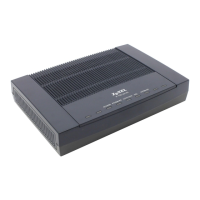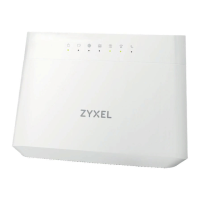Chapter 9 VDSL Setup
VES1724-56 User’s Guide
118
9.3.8 VDSL G.INP Setup
Click the Modify link in the VDSL Channel Profile Setup screen to open the screen shown below.
Use this screen to modify the G.INP settings.
Figure 62 VDSL Channel Profile Setup > G.INP
The following table describes the labels in this screen.
Table 41 VDSL Channel Profile Setup > G.INP
LABEL DESCRIPTION
DownStream The parameters in this column relate to downstream transmissions.
Upstream The parameters in this column relate to upstream transmissions.
G.INP Mode Select G.INP retransmission mode.
Forbidden: G.INP is disabled on the Switch.
Preferred: G.INP is enabled if the far-end (CPE device) supports it.
Forced: The VDSL connection can be established only if the far-end supports G.INP mode.
Test: G.INP is enabled only in test mode.
Effective
Throughput
Specify the maximum and minimum value allowed for the ETR (Effective Throughput
Rate).
Net Data
Rate(NDR)
Specify the maximum downstream/upstream net data rate.
Shine Ratio Specifies the loss of data rate you predict to occur within 1 second due to SHINEs (Single
high impulse noise events).
The valid values are all multiples of 0.001 and between 0 and 0.1.
LEFTR Threshold Specify the lower rate limit (fraction of NDR). A Low Error Free Rate (LEFTR) defect is
declared when the rate falls below the threshold.
Max Delay Specify the maximum delay (from 1 to 63 in ms) that is added to the retransmission delay
caused by retransmissions.
Min Delay Specify the minimum delay (from 0 to 63 in ms) that is added to the retransmission delay
caused by retransmissions.
Min INP Specify the minimum level of impulse noise (burst) protection.

